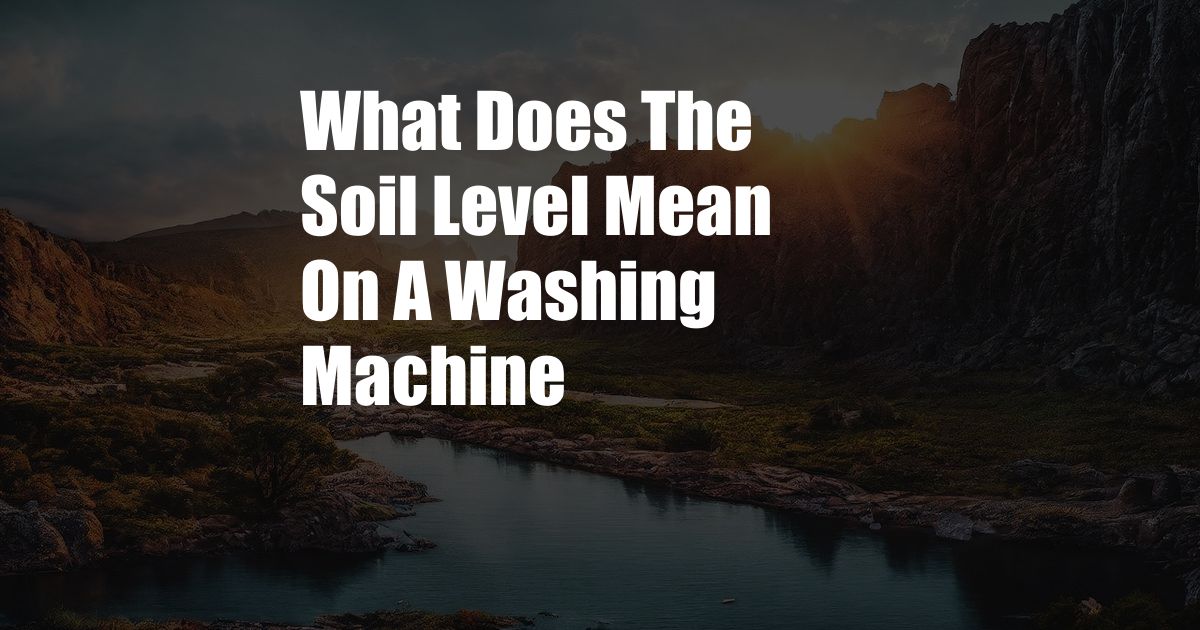
What Does the Soil Level Mean on a Washing Machine?
As I sorted a pile of laundry, I noticed a mysterious dial marked “Soil Level” on my washing machine. Curiosity got the better of me, and I set out to understand the cryptic message hidden within those words. Little did I know that this unassuming control held the secret to optimizing my washing routine, ensuring pristine and sparkling clean clothes every time.
From heavily soiled work clothes to delicate fabrics, the soil level setting empowers us to customize the wash cycle to suit the specific needs of our garments. By understanding the various soil levels and their corresponding wash cycles, we can bid farewell to dull, dingy laundry and embrace a world of vibrant, fresh-smelling fabrics.
Meaning and Function of Soil Level
The soil level setting on a washing machine indicates the degree of dirt and grime present on the clothes being washed. It determines the intensity of the wash cycle, including water temperature, agitation speed, and spin speed. Higher soil levels call for more vigorous wash cycles, while lower soil levels warrant gentler cycles.
By selecting the appropriate soil level, we ensure that our clothes receive the optimal cleaning they deserve, without risking damage to delicate fabrics or leaving stubborn stains behind. It’s like having a personal laundry consultant at our fingertips, guiding us towards the perfect wash cycle.
Navigating Soil Level Options
Most washing machines offer three primary soil level settings: Light, Medium, and Heavy.
- Light Soil Level: This setting is ideal for lightly soiled clothes, such as those worn for a day in an office environment or for light physical activities. It uses a gentle wash cycle with lower water temperature and agitation to avoid excessive wear and tear on delicate fabrics.
- Medium Soil Level: This setting is suitable for moderately soiled clothes, such as those worn during outdoor activities or for light manual work. It employs a more vigorous wash cycle with higher water temperature and agitation to remove dirt and stains effectively.
- Heavy Soil Level: This setting is reserved for heavily soiled clothes, such as work uniforms, sports gear, or clothes stained with grease or oil. It utilizes the most intense wash cycle with the highest water temperature and agitation to tackle stubborn stains and grime.
Choosing the correct soil level is crucial for achieving optimal washing results. Selecting a higher soil level than necessary can damage delicate fabrics, while opting for a lower soil level might leave visible stains or dirt behind.
Tips for Selecting the Right Soil Level
To ensure your clothes receive the best possible care, follow these tips when selecting the soil level:
- Consider the Fabric Type: Delicate fabrics, such as silk, lace, or wool, require a light soil level to avoid damage. Heavier fabrics, such as denim or canvas, can withstand higher soil levels.
- Check for Stains: If your clothes have visible stains, opt for a higher soil level to ensure they are thoroughly removed.
- Assess the Level of Dirt: If your clothes are covered in dirt or grime, select a higher soil level for a more intensive wash.
- Follow Care Labels: Always refer to the care labels on your clothes for specific washing instructions, including the recommended soil level.
Remember, the goal is to find the optimal balance between removing stains and dirt without damaging the fabric. Err on the side of caution if unsure and select a lower soil level. It’s always better to be gentle with your clothes than to risk irreversible damage.
FAQ on Soil Level Settings
Q: What is the difference between soil level and load size?
A: Soil level refers to the degree of dirt and grime on the clothes, while load size indicates the amount of clothes being washed. Both factors influence the wash cycle, ensuring optimal cleaning for your laundry.
Q: Can I use a higher soil level setting for all my clothes?
A: No, using a higher soil level than necessary can damage delicate fabrics. Always select the appropriate soil level based on the specific needs of your clothes.
Q: What should I do if my clothes have heavy stains?
A: For heavily stained clothes, pretreat the stains with a stain remover and select a higher soil level setting to ensure thorough removal.
Q: Is it okay to wash lightly soiled clothes on a higher soil level setting?
A: It is not recommended to use a higher soil level setting than necessary, as it can cause excessive wear and tear on delicate fabrics.
Conclusion
Understanding the soil level on your washing machine empowers you to customize the wash cycle to the specific needs of your clothes, ensuring they emerge sparkling clean and fresh. By selecting the appropriate soil level, you not only protect your garments from damage but also optimize their lifespan. So, next time you approach your laundry pile, remember the power of the soil level setting and embrace the joy of pristine, vibrant clothes.
Are you curious to learn more about the fascinating world of laundry and cleaning? Share your thoughts and questions in the comments below, and let’s explore the enchanting realm of sparkling clean fabrics together.